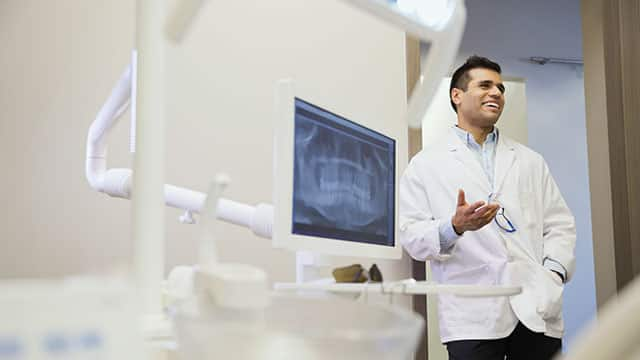Where Are the Nerves in Teeth?
The hard, white, visible portion of your teeth is known as enamel. This part of the tooth doesn't have any nerves. In fact, as the American Dental Association points out, enamel doesn't have any living cells at all.
The layer of the tooth beneath the enamel is called the dentin, and if the enamel gets damaged, the dentin can be exposed. Dentin contains microscopic tubules that let sensation travel deeper into the tooth. When hot or cold foods or drinks touch the dentin, the nerves deep inside the tooth can be stimulated.
The nerves are located in the middle of the tooth, within soft tissue called pulp. The pulp also contains blood vessels and connective tissue. If this part of the tooth becomes infected or damaged, your dentist may opt to relieve your discomfort by removing the nerves causing your pain.
Possible Causes of Severe Dental Pain
If you experience severe dental pain, you should see your dentist as soon as possible to determine what's causing your toothache. Here are a few possible causes:
Tooth Decay
Tooth decay forms when oral bacteria produce acids that eat into the tooth enamel. Over time, a hole — known as a cavity — can form in the tooth. When cavities first develop, they don't usually hurt, as the National Institute of Dental and Craniofacial Research notes. However, as the decay gets worse, you may experience pain in the tooth or sensitivity to hot or cold temperatures.
Cracked Teeth
Teeth are strong, but they may crack if you chew hard objects, such as ice or unpopped popcorn kernels, as the American Academy of Endodontists (AAE) warns. Other possible causes of cracked teeth include bruxism (clenching and grinding teeth) and sporting accidents. When the tooth enamel cracks, the pieces may move when you chew. This movement can irritate the tooth's pulp and eventually cause irreparable damage. A cracked tooth may hurt when you chew, or it may be sensitive to hot and cold temperatures. Often, the pain comes and goes.
Dental Abscess
A tooth abscess is a pocket of pus that can form at different regions in a tooth, including the tip of the tooth's root, as the Mayo Clinic explains. This infection occurs when bacteria get inside the tooth's pulp. This could happen if you have a cavity or dental injury that's been left untreated. An abscessed tooth may be sensitive to chewing forces or hot or cold temperatures. You may experience a severe, throbbing toothache, and the pain can even reach your ear, jawbone or neck. Other potential signs of a tooth abscess include facial swelling and a fever.
Treatment for Severe Dental Pain
If you have severe dental pain, see your dentist as soon as possible. Depending on the cause of the pain, your dentist may refer you to an endodontist, which is a dentist that specializes in treating the interior of the tooth.
In cases where the tooth's pulp is infected or inflamed, the dental professional may recommend a root canal, as the AAE explains. During this relatively simple procedure, they will make an opening in the tooth and remove the infected or inflamed pulp. Once the pulp has been removed, they will fill the empty space inside the tooth with a filling material. Usually, dentists use gutta-percha, which is a rubber-like material with an adhesive cement. To protect the treated tooth, your dentist will then place a restoration, such as a crown.
While a root canal will remove a tooth nerve by removing the pulp, it doesn't kill the tooth. The AAE reassures that a tooth that's been treated with a root canal can still function normally.
Severe dental pain may be a sign of a serious dental condition, such as a cavity, a cracked tooth or a tooth abscess. Because these conditions can't be treated at home, you should see your dentist as soon as possible, so they can diagnose and resolve your toothache.
Oral Care Center articles are reviewed by an oral health medical professional. This information is for educational purposes only. This content is not intended to be a substitute for professional medical advice, diagnosis or treatment. Always seek the advice of your dentist, physician or other qualified healthcare provider.
ORAL HEALTH QUIZ
What's behind your smile?
Take our Oral Health assessment to get the most from your oral care routine
ORAL HEALTH QUIZ
What's behind your smile?
Take our Oral Health assessment to get the most from your oral care routine















